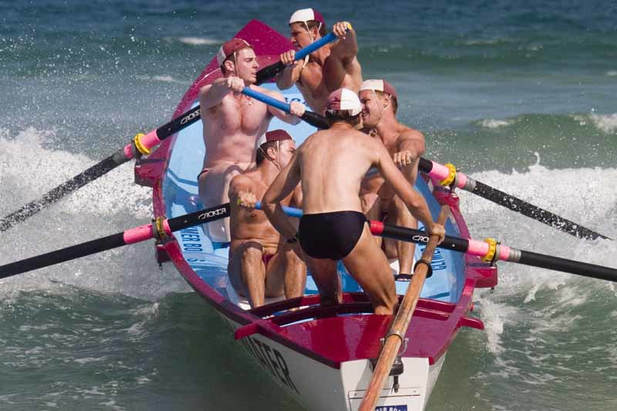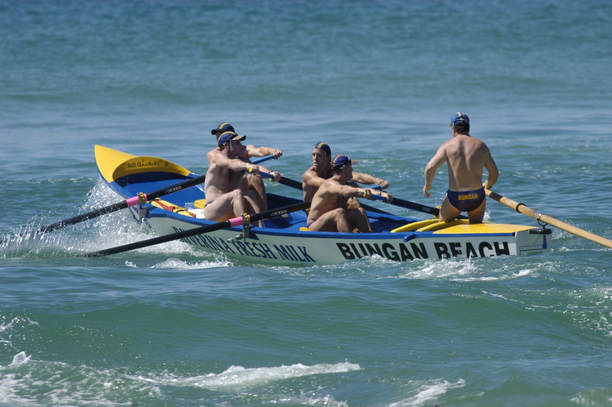ROWING SKILLS
ROWING
The break through moment coaching a crew is when they understand rowing is as much about rhythm and feel for the ocean as it is about strength and fitness.
SURFBOAT ROWING STYLE
Surfboat rowing is often taught and coached in the same way as still water rowing. Wrong, wrong, wrong! There are close similarities but a surfboat hull and its environment is extremely different.
Surfboat rowing technique must be attuned to a heavier craft and varying beach and surf conditions.
Surfboat rowing technique can be expressed in various phases that flow into each other. It can be simply explained as the ‘catch’, ‘drive’ and ‘recovery’ or in more detail as the ‘catch’, early drive’, ‘drive’,’ late drive’, ‘finish’ and ‘recovery’.
‘Catch’ involves placement of the blade in the water and initial application of power. This includes using the hands and perhaps the body to find the water when the surfboat bow rises over waves and swells.
‘Drive’ or ‘pull’ is the remainder of the effort through the water using body and leg power. At the end of the drive the blade is removed (disengaged) from the water referred to as the ‘finish’.
An important concept to explain to surfboat rowers is that the blade does not actually pull through the water. Rather the oar blade remains almost in the same fixed position in the water. Leverage through the oar shaft pulls the boat past the blade.
‘Recovery’ commences once the blade is released from the water at the end of the stroke. The rhythm of a boat which encourages run is achieved by the recovery method. The recovery should not be rushed. If the recovery is done by quickly rushing the body forward it will slow the ‘run’ by lifting the bow in a jerky fashion. Boats will run best when the hull is level longitudinally (bow to tuck).
'Application of power' on the four blades should be synchronized throughout the stroke to maximize run and boat speed. Surfboat rowers require a special skill to be able to synchronise the application of power on their blades with each other when water surface conditions may differ between them.
Surfboat rowing is often taught and coached in the same way as still water rowing. Wrong, wrong, wrong! There are close similarities but a surfboat hull and its environment is extremely different.
Surfboat rowing technique must be attuned to a heavier craft and varying beach and surf conditions.
Surfboat rowing technique can be expressed in various phases that flow into each other. It can be simply explained as the ‘catch’, ‘drive’ and ‘recovery’ or in more detail as the ‘catch’, early drive’, ‘drive’,’ late drive’, ‘finish’ and ‘recovery’.
‘Catch’ involves placement of the blade in the water and initial application of power. This includes using the hands and perhaps the body to find the water when the surfboat bow rises over waves and swells.
‘Drive’ or ‘pull’ is the remainder of the effort through the water using body and leg power. At the end of the drive the blade is removed (disengaged) from the water referred to as the ‘finish’.
An important concept to explain to surfboat rowers is that the blade does not actually pull through the water. Rather the oar blade remains almost in the same fixed position in the water. Leverage through the oar shaft pulls the boat past the blade.
‘Recovery’ commences once the blade is released from the water at the end of the stroke. The rhythm of a boat which encourages run is achieved by the recovery method. The recovery should not be rushed. If the recovery is done by quickly rushing the body forward it will slow the ‘run’ by lifting the bow in a jerky fashion. Boats will run best when the hull is level longitudinally (bow to tuck).
'Application of power' on the four blades should be synchronized throughout the stroke to maximize run and boat speed. Surfboat rowers require a special skill to be able to synchronise the application of power on their blades with each other when water surface conditions may differ between them.
STROKE RATE
Stroke rate can increase and decrease at various stages of a race. Experiment the rates that work best for your crew. Light crews that are not particularly powerful may benefit from a higher rate.
A higher rate is not necessarily better than a slower one. The ‘recovery’ when the body is sliding back to take the next stroke, is a critical stage. Power may diminish if the recovery is too rushed in order to row with a high rate. Rushing the recovery will tire rowers more quickly.
Effective stroke rate mainly depends on the style of rowing and stage of a race. Styles which accentuate length through the water, with a relaxed recovery, may tend to have a slower effective rate.
The rhythm of the rowing may be more significant to performance than the stroke rate. Talk to the crew about ‘the feel’ of the boat and the best way to encourage rhythm and boat speed.
High stroke rates can test fitness levels and put pressure on rowers towards the end of the race.
Stroke rate can increase and decrease at various stages of a race. Experiment the rates that work best for your crew. Light crews that are not particularly powerful may benefit from a higher rate.
A higher rate is not necessarily better than a slower one. The ‘recovery’ when the body is sliding back to take the next stroke, is a critical stage. Power may diminish if the recovery is too rushed in order to row with a high rate. Rushing the recovery will tire rowers more quickly.
Effective stroke rate mainly depends on the style of rowing and stage of a race. Styles which accentuate length through the water, with a relaxed recovery, may tend to have a slower effective rate.
The rhythm of the rowing may be more significant to performance than the stroke rate. Talk to the crew about ‘the feel’ of the boat and the best way to encourage rhythm and boat speed.
High stroke rates can test fitness levels and put pressure on rowers towards the end of the race.
STROKE RATE TRAINING
Some points to consider during training in relation to stroke rate are:
Some points to consider during training in relation to stroke rate are:
- Train at a similar rate that the crew will row in competition.
- Avoid too much emphasis on specific strokes per minute. Refer to rate more subjectively in terms of ‘a little slower’ or ‘a little higher’.
- The Second Stroke must assist the Stroke to lift the rate. Practise combining the Stroke and Second Stroke to change the rate when they are a little tired. It is much easier to adjust the rate when rowers are fresh.
- On ‘long’ early season rows do not allow the effort to drop simply because the rate is low. On long rows call a few efforts with an increased rate to maintain focus and add interest.
- Concentrating on power while rowing with a slow rate can be very effective. It helps to maintain boat speed in a race during the transition after a dynamic start or effort.
- During ‘fartlek’ training efforts maintain a race rate. Lower it during the lighter strokes.
- During ‘minute on / minute off’ training the rate is similar to fartlek training. The rate may be slightly lower during the minute ‘off’ and race rate during the minute ‘on’.
- Training over ‘race courses’; ‘starts’; and ‘buoy turns’; the rate should be the same as in competition.
- ‘100 stroke power builds’ increase in intensity each 20 strokes. Start with a slightly lower rate and increase it as the effort builds. The last two 20 stroke sections should be at a rate similar to that at the end of a race. The increase in rate from the start of the power builds to the finish may only be about six strokes per minute.
- Rowing ‘150 strokes’ or ‘80 strokes’ in training should be done at race intensity with race rates.
- During ‘42 strokes’ training the stroke rate is the same as at the finish of a race. The rate during this exercise may be the fastest the crew will use, due to the amount of power exerted in a short time.


